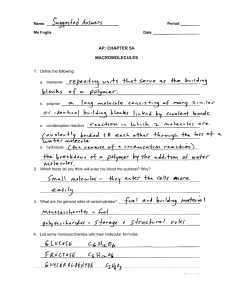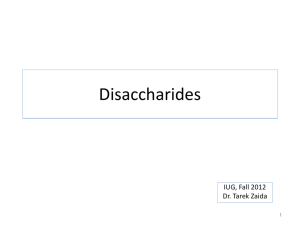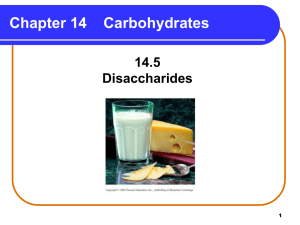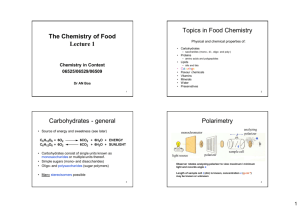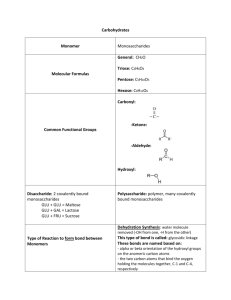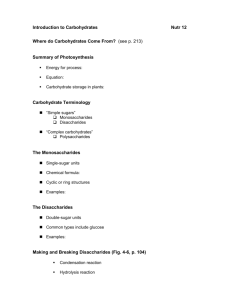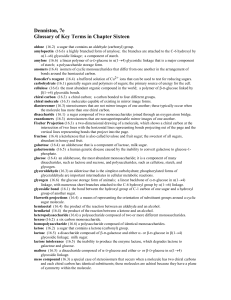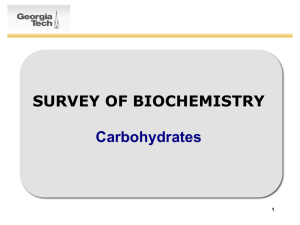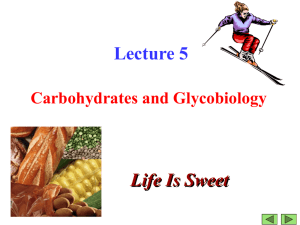¨ Not all carbohydrates have the empirical formula (CH2O)n
advertisement
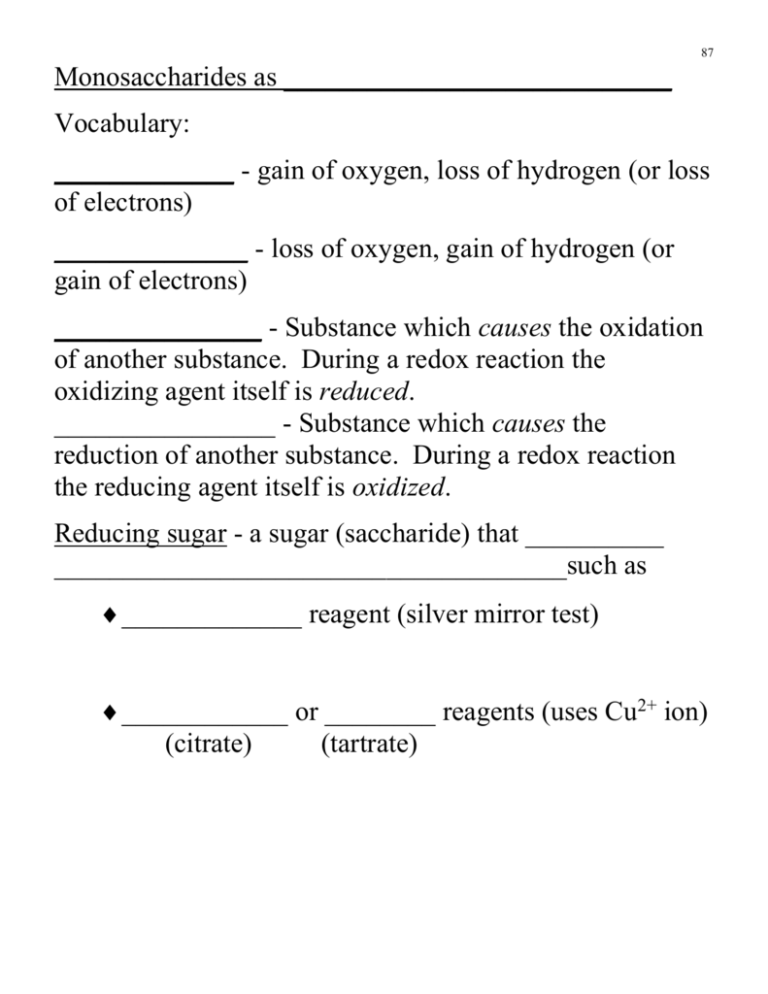
87 Monosaccharides as ____________________________ Vocabulary: _____________ - gain of oxygen, loss of hydrogen (or loss of electrons) ______________ - loss of oxygen, gain of hydrogen (or gain of electrons) _______________ - Substance which causes the oxidation of another substance. During a redox reaction the oxidizing agent itself is reduced. ________________ - Substance which causes the reduction of another substance. During a redox reaction the reducing agent itself is oxidized. Reducing sugar - a sugar (saccharide) that __________ _____________________________________such as _____________ reagent (silver mirror test) ____________ or ________ reagents (uses Cu2+ ion) (citrate) (tartrate) 88 With these tests the reagent gets reduced while the _____ ____________________________________. oxidation of aldehydes: In solution, monosaccharides -predominantly in cyclic forms. The cyclic hemiacetals or hemiketals cannot react directly with the oxidizing agents. Recall equilibrium for glucose (an aldose): The ____________________ form. The trace amount of linear form will react. The equilibrium shifts by Le Chatelier’s Principle. Eventually, all will react. All monosaccharide aldoses are aldehydes and can react with the oxidizing agents. They all are _______________________ 89 Ketones normally do not react with mild oxidizing agents. However, the ketoses are __________________. These are in equilibrium with an aldehyde form. The aldehyde form is a reducing sugar. Therefore, all monosaccharide ketoses are also reducing sugars. 90 __________________ - (have 2 linked monosaccharides) We will examine: ____________ - _____________, main carbohydrate in mammalian milk (people who are lactose intolerant lack the enzyme lactase and cannot digest milk) ______________ - ______________ Recall from organic chemistry: hemiacetal + hemiketal + alcohol alcohol ⇄ acetal ⇄ ketal + water + water 91 Lactose -D- galactose + -D-glucose lactose + water An _________________________ joins the monomers. The link here is __________________ Question? Is lactose a reducing sugar? Answer_________________________________________ _______________________________________________ _______________________________________________ 92 Sucrose -D-glucose + -D-fructose sucrose + water Note: Fructose’s normal Haworth projection is flipped here to put reactive groups close. Link is _______________________ Question? Is sucrose a reducing sugar? Answer. No, because the glycosidic bond joins the anomeric carbon atoms from both monomers. Neither monomer is any longer in equilibrium with the reactive linear form (rings are locked in place and cannot open up). No reaction with Tollen’s, Benedict’s or Fehling’s reagents. Sucrose is a ___________________________. 93 ____________________s - (polymers of monosaccharides) Polysaccharides are also called _______________ _____________ - homopolymer (identical monomer units) _____________ - heteropolymer (2 or more types of monomer units) Polysaccharides can be either branched or linear polymers. We will look at: Starch Glycogen Cellulose 1. ______ – in __________ granules ______________ Starch is a _____________ of 2 polysaccharides ________ - monomer is _______________ _________________________ _____________ 2o structure _____________ linkage __________ - monomer is ______________ __________________________ branching prevents helix formation main chain is _____________ branch points are _________ linkage branches _______ units apart; length about ______ units _______- digestive enzyme (saliva) ______________ links 94 2. ____________ - found in ______, primarily in the ____ in mammals, ___________, regulates blood glucose levels 10% of the liver is glycogen 2% in muscle Structure is nearly ______________________ Differences from amylopectin: _________________ more ________________ from main chain (every _______________ units) branches are ___________ 3. _______________ - most abundant polysaccharide main component of _____________ (structural function); strong to withstand changes in turgor pressure. monomer is ____________________ _______________________ has ________________ linkage ____________ fibers, can ________ form layers very strong Hydrolyzed by the ________________. Humans do not have this, so don't eat grass! Cows, termites, etc. have cellulase by the microrganisms in their digestive systems.
